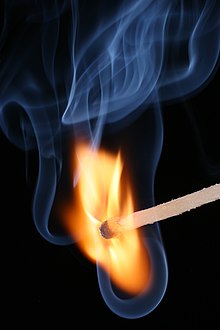Chemical change: Difference between revisions
| Line 38: | Line 38: | ||
ILOVEALEXBANDASHLEYO! |
|||
ILOVEALEXB |
|||
== References == |
== References == |
||
Revision as of 16:38, 19 November 2008

A chemical change occurs whenever compounds are formed or decomposed. During this reaction, there is a rearrangement of atoms that makes or breaks chemical bonds. This change is usually not reversible, unlike physical changes, which typically are reversible. In short, chemical change is a change of one substance into another substance (i.e. a new substance is formed). By contrast, no new substance is formed in a physical change (for example, the melting of ice is a physical change because when ice changes into water, no new substance is formed.)
In a chemical reaction, bonds are broken and new bonds are formed between different atoms. This breaking and forming of bonds takes place when particles of the original materials collide with one another. Some exothermic reactions may be hot enough to cause certain chemicals to also undergo a change in state; for example in the case of aqueous solutions, bubbles may not necessarily be newly produced gas but instead water vapor.
Chemical changes are happening very often. When wood burns it is a chemical change. There are several different types of chemical change. These include synthesis, decomposition, single displacement, double displacement, neutralization, precipitation and redox.
An elementary example of a chemical change is the combustion of methane to produce carbon dioxide and water:
- CH
4 + 2O
2 → CO
2 + 2H
2O
Other examples of chemical changes are:
- Burning a log of wood.
- Mixing an acid with a base, producing water and a salt.
- Photosynthesis - a process in which carbon dioxide and water are changed into sugars by plants.
- Cracking heavy hydrocarbons to create lighter hydrocarbons (part of the process of refining oil).
- cooking examples:popcorn cake & eggs
- oxidation examples:rust or tarnishing
The following can indicate that a chemical change took place, although this evidence is not conclusive:
- Change of color (for example, silver to reddish-brown when iron rusts).
- Change in temperature or energy, such as the production (exothermic) or loss (endothermic) of heat.
- Change of form (for example, burning paper).
- Light, heat, or sound is given off.
- Formation of gases, often appearing as bubbles.
- Formation of precipitate (insoluble particles).
- The decomposition of organic matter (for example, rotting food).
See also
ILOVEALEXBANDASHLEYO!
References
- Zumdahl, Steve S. (2005), Chemical Principles (5 ed.), Houghton Mifflin, ISBN 0618372067
